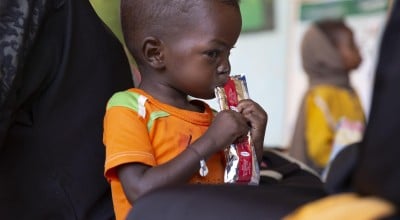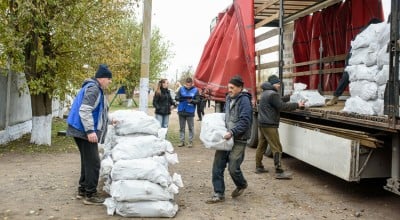
Read our 2024 annual report

Knowledge Hub
Six more children every minute face severe hunger in crisis-hit East Africa
Six more children a minute face severe hunger in East Africa as millions of people continue to flee drought and conflict, says Concern Worldwide.
- Number of children aged under five in East Africa facing acute malnutrition is nine times Ireland’s population of under-fives and two and a half times Ireland’s total child population (0 to 17-year-olds) of 1.2 million
- Irish aid worker describes the “vacant stares” of malnourished children who arrive at nutrition centres run by Concern Worldwide in South Sudan where they get life-saving treatment
Ireland’s largest international humanitarian aid agency has said there are over three million children aged under five in South Sudan, Somalia, Kenya and Ethiopia, who are expected to be treated for moderate or severe acute malnutrition by the end of 2017.
This means an average of six children every minute face a grim future if they are not treated and do not get adequate food and nutrition in time.
The stark figure of three million East African children facing acute malnutrition is also two and a half times Ireland’s child population of 1.2 million and almost nine times the 355,588 Irish children aged four and under.
The level of malnutrition is getting worse – especially among young children and vulnerable groups such as the elderly and people living with disabilities,” warned Concern Worldwide South Sudan Country Director, Fiona McLysaght.
Fiona, from Tuamgraney, Co. Clare, said her team of 350 Concern staff provide life-saving assistance to pregnant women and children under the age of five, who are most vulnerable to malnutrition when nutritious food and water are scarce.
When asked what hunger looks like in war-torn South Sudan - which is the world’s youngest country - Fiona said:
“A hungry child looks sad and scared; their skin is dull and sagging; their frame is small and fragile and they have no energy to walk, talk or play.
The inquisitive look of a well-fed child is replaced with vacant stares.
We are treating malnourished children and women in one of the counties – Leer – where famine was declared in February, and although this status has been withdrawn, 1.7 million people are still on the brink of starvation.
There are two million people that have had to leave their homes, and 1.8 million people, one million of whom are children, have fled the country and are living in refugee camps in neighbouring countries.
Humanitarian aid will help to save lives and alleviate suffering, but without a political solution the situation looks dire.
Fiona is one of over 1,200 Concern staff responding, often in collaboration with other organisations, to the crisis across East Africa, where an estimated 20 million men, women and children are suffering from hunger, disease, displacement and violence.
Relief workers have had to wade through swamps on foot and in canoes in some areas to try and reach people fleeing conflict, which remains the main obstacle to humanitarian assistance reaching those most in need.
As the crisis persists, Concern is continuing to respond and is appealing for donations for its East Africa appeal, which can be made at www.concern.net.
For more information or interview requests, please call Kevin Jenkinson at 086 358 2886 or by email: kevin.jenkinson@concern.net.
About Severe Acute Malnutrition
Severe acute malnutrition is a life threatening condition requiring urgent treatment. It affects an estimated 19 million children under five years of age (between birth and four) worldwide and is estimated to account for 400,000 child deaths each year, according to the World Health Organisation. In children who are six to 59 months of age, severe acute malnutrition is defined by a very low weight-for-height/weight-for-length, or clinical signs of bilateral pitting oedema, or a very low mid-upper arm circumference.
Early identification of severe acute malnutrition is important for initiating treatment and minimising the risk of complications. Malnutrition refers to deficiencies, excesses, or imbalances in a person’s intake of energy and or nutrients. It addresses three broad groups of conditions such as under-nutrition, which includes wasting (low weight-for-height), stunting (low height-for-age) and underweight (low weight-for-age).
Other ways to help
Corporate support
Is your company interested in working together for a common cause?
Fundraise for Concern
From mountain trekking to marathon running, cake sales to table quizzes, there are lots of ways you can support our work.
Buy a gift
With an extensive range of alternative gifts, we have something to suit everybody.
Leave a gift in your will
Leave the world a better place with a life-changing legacy.
Volunteer with Concern
The lots of ways to get involved with our work as a volunteer
School fundraising
Without the generous support from schools, we wouldn't be able to do the work that we do.




